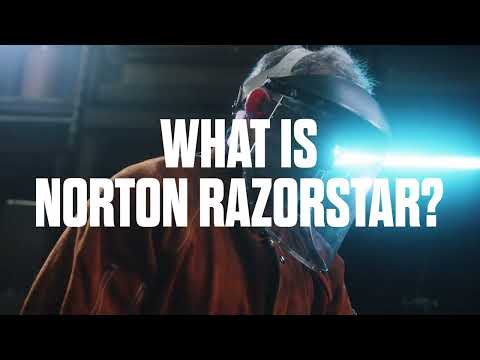Norton Tames Tough Grinding Jobs with RazorStar™
New Norton RazorStar™ discs and belts enable machinists to complete grinding jobs more quickly, freeing them for other tasks and improving efficiency in a tight labor market.
New Norton RazorStar™ discs and belts enable machinists to complete grinding jobs more quickly, freeing them for other tasks and improving efficiency in a tight labor market.
The value of RazorStar™, the new line of ceramic grain cutting technology from Norton, lies not only in what it can do but what it can keep users from having to do themselves.
For starters, changing cutting tools as often as they do now.
RazorStar™ fiber discs, quick-change discs and belts—introduced in January— feature razor-sharp grains combined with a supersized grinding aid that helps significantly reduce potentially harmful heat generation. Along with reducing the risk of workpiece damage, that can also prolong tool life when working with materials from carbon steel to aluminum, stainless steel and nickel alloys.
Much like consumers drawn to new cars and the latest technology in smartphones, machinists and manufacturers are always looking for the next best thing “and that’s what RazorStar™ is,” says Jeremy Spencer, a product manager for the coated abrasives division of Norton, owned by the French manufacturer Saint-Gobain. “We’ve built a product that’s easier to use in applications for which some workers might have previously relied on a grinding wheel or stone—which was loud, vibrated a lot, gouged workpiece material and required finesse to master.”

In many cases, machinists used large 7- to 9-inch grinders that accommodated wider discs to shape large surface areas more quickly, he explains.
“We wanted to create a product that made it easier for users: With RazorStar™, you can use a fiber disc rather than a grinding wheel because it has a much higher material removal rate than some of these products that have been on the market for the past several decades,” Spencer says. “You can back off from some of those huge tools and old ways of doing the job.”
More efficient material removal means businesses don’t have to replace tools as often and can deliver customers’ orders more quickly.
“If it normally takes two minutes to grind something and it now takes a fraction of that, it means they can grind more welds in one day or bevel more material,” Spencer says. “We’re pushing the bar higher, which is good for the customers.”

The [unique patented geometry](https://www.nortonabrasives.com/en-us/newsroom/press_releases/norton-razorstar-abrasives-offer-unprecedented-grinding-performance#:~:text=WORCESTER%2C%20MA%2C%20U.S.A.%20(January,breakthrough%20technology%20with%20unbeatable%20performance) of the RazorStar™ and its tough micro-structure enable the ceramic grains to stay sharp during use, with new cutting points exposed as the grain fractures, Norton says. The design includes a high concentration of grains in an upright position so that the abrasives are ready to perform aggressively at their sharpest point, the company adds.
The 36-grit RazorStar™ is available in:
Fiber discs ranging from 4 ½ inches to 9 inches in 7/8 hole, speed-change and AVOS (allows visibility of surface) discs. Key markets include maintenance, repair and operations; metal fabrication; welding; oil and gas; energy and ship building.
Quick-Change Discs in 2- and 3-inch sizes, featuring a strong backing that stands up to extreme pressure when removing stock, deburring, beveling and blending. These are especially well-suited to aerospace, metal fabrication, welding and energy industry applications.
Belts, which are made-to-order and ideal for impact grinding, robotic or off-hand applications in markets such as foundry, aerospace, automotive, metal fabrication, oil and gas and general engineering.
RazorStar™ fiber discs have demonstrated as much as a 50 percent improvement in cutting performance compared with other ceramic discs, Norton says, and RazorStar™ belts are producing the same number of parts with fewer belt changes and less machining and changeover time.
“Because of the technology, the price per disc will be higher than previous ceramic discs and zirconia and aluminum oxide tools, but our field tests show that most of the time, the operator isn’t having to push as hard to break down that grain and keep cutting because the RazorStar™ is so sharp,” Spencer says. “Customers then realize that, ‘Maybe I’m paying more for the RazorStar™, but look how much I’m saving because of the reduced time for the operator.’”
Since jobs done with the RazorStar™ typically require less time than they did previously, machinists using it are freed to tackle other responsibilities, a significant benefit as manufacturers and metalworking businesses grapple with a labor shortage expected to reach 2.1 million jobs by 2030.
Another benefit of the technology’s superior cutting ability is a reduction in the physical demands of grinding, which means candidates who couldn’t have handled the job in the past are now able to, allowing employers more latitude in a tight labor market, Spencer says.
And because RazorStar™ customers aren’t having to run their grinders as long, they’re reducing their carbon footprint, which pleases customers and investors prioritizing sustainability.
Users have been particularly pleased with the smooth finishes achieved with RazorStar™, which has enabled some of them to skip steps required with older tools, Spencer says.
“That’s where you can really save money as a customer,” he adds, “if a job previously took three steps and now, because you changed the beginning step, it only requires two.”
How could RazorStar™ grinding tools improve your shop’s productivity? Tell us in the comments below.




